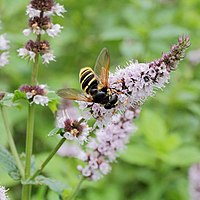
Photo from wikipedia
Mint species (Lamiaceae family) have been used as traditional remedies for the treatment of several diseases. In this work, we aimed to characterize the biological activities of the total phenolic… Click to show full abstract
Mint species (Lamiaceae family) have been used as traditional remedies for the treatment of several diseases. In this work, we aimed to characterize the biological activities of the total phenolic and flavonoid contents of Mentha pulegium L. extracts collected from two different regions of Tunisia. The highest amounts of total phenols (74.45 ± 0.01 mg GAE/g DW), flavonoids (28.87 ± 0.02 mg RE/g DW), and condensed tannins (4.35 ± 0.02 mg CE/g DW) were found in the Bizerte locality. Methanolic leaf extracts were subjected to HPLC-UV analysis in order to identify and quantify the phenolic composition. This technique allowed us to identify seven phenolic compounds: two phenolic acids and five flavonoid compounds, such as eriocitrin, hesperidin, narirutin, luteolin, and isorhoifolin, which were found in both extracts with significant differences between samples collected from the different regions (p < 0.05). Furthermore, our results showed that the methanolic extract from leaves collected from Bizerte had the highest antioxidant activities (DPPH IC50 value of 16.31 μg/mL and 570.08 μmol Fe2+/g, respectively). Both extracts showed high radical-scavenging activity as well as significant antimicrobial activity against eight tested bacteria. The highest antimicrobial activities were observed against Gram-positive bacteria with inhibition zone diameters and MIC values ranging between 19 and 32 mm and 40 and 160 µg/mL, respectively. Interestingly, at 10 μg/mL, the extract had a significant effect on cell proliferation of U87 human glioblastoma cells. These findings open perspectives for the use of Mentha pulegium L. extract in green pharmacy, alternative/complementary medicine, and natural preventive therapies for the development of effective antioxidant, antibacterial, and/or antitumoral drugs.
Journal Title: Molecules
Year Published: 2022
Link to full text (if available)
Share on Social Media: Sign Up to like & get
recommendations!